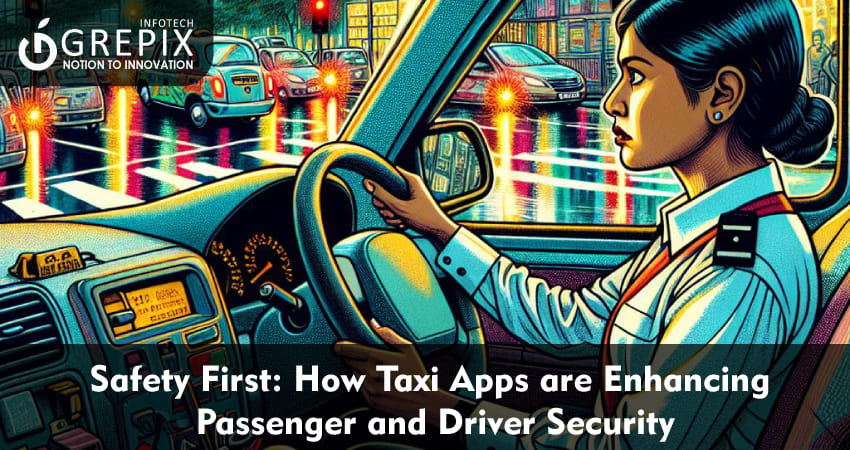Safety First: How Taxi Apps are Enhancing Passenger and Driver Security
In an era where convenience meets technology, taxi apps have transformed urban mobility. With the push of a button, passengers can summon a ride, and drivers can find work, making commuting more efficient and accessible. However, along with the ease of use comes a critical concern: safety. Ensuring the security of passengers and drivers has become a cornerstone of the taxi app industry, shaping how these platforms operate and innovate.
Safety is the foundation of trust, and taxi apps have embraced this principle by implementing comprehensive measures to protect passengers and drivers. From rigorous vetting and GPS tracking to AI-driven innovations and gender-specific initiatives, these platforms are continually evolving to address safety concerns. As technology advances and the industry matures, taxi apps will play an increasingly vital role in ensuring secure and seamless transportation for all. This blog explores how taxi apps are enhancing safety measures to create a secure environment for both riders and drivers.
Taxi apps have revolutionized urban mobility, offering passengers and drivers efficient and accessible transportation options. However, safety remains a critical focus. Platforms address this through rigorous driver screenings, real-time GPS tracking, in-app safety features, and AI-powered innovations. Pandemic-driven solutions, such as contactless payments and health protocols, have further enhanced user trust. Initiatives like women-only rides and driver safety enhancements emphasize inclusivity and mutual protection. Collaboration with law enforcement, insurance coverage, and adherence to regulations strengthen security. As safety technologies evolve, taxi apps set new benchmarks, ensuring secure, seamless, and user-friendly experiences for all stakeholders.
1 Rigorous Driver Screening Processes
A cornerstone of taxi app safety is the meticulous vetting of drivers. Leading platforms like Uber, Lyft, and Bolt implement multi-step background checks before allowing drivers onto their platforms. These checks often include:
- Criminal Background Checks: Verifying that drivers have no criminal history that could pose a risk to passengers.
- Driving Records: Ensuring drivers possess valid licenses and a clean driving history.
- Identity Verification: Using government-issued identification and, in some cases, biometric data to confirm authenticity.
These measures provide passengers with peace of mind, knowing their driver has passed stringent screening processes.
2Real-Time GPS Tracking
GPS tracking is a game-changing feature that benefits both passengers and drivers. Every trip is tracked in real-time, allowing passengers to share their journey with trusted contacts. This visibility enhances security in multiple ways:
- Emergency Assistance: If something goes wrong, passengers and drivers can easily alert authorities or the app’s support team.
- Route Transparency: Passengers can monitor their journey, reducing the risk of drivers deviating from the intended route.
- Post-Trip Accountability: Should disputes arise, trip data provides a reliable record of events.
3In-App Safety Features
Taxi app are increasingly integrating safety-focused features to address potential risks during rides. These include:
- Emergency SOS Buttons: Many apps have an SOS button that connects users directly to emergency services or the platform's safety team.
- Ride Verification: Passengers can verify their driver’s identity by matching the car's license plate, model, and driver photo in the app.
- Reviews and Ratings: Passengers and drivers rate each other after a trip. This mutual accountability promotes respectful behavior and helps platforms identify problematic users or drivers.
4Contactless Features for Pandemic Safety
The COVID-19 pandemic underscored the need for physical safety measures. Taxi apps responded by introducing features to minimize contact:
- Contactless Payments: Encouraging cashless transactions via in-app payments.
- Health Declarations: Requiring both drivers and passengers to confirm they are symptom-free before rides.
- Mask Policies: We can mandate mask-wearing and provide hygiene kits for drivers.
These measures not only addressed immediate health concerns but also reinforced passenger trust in the platform's commitment to safety.
5 AI and Machine Learning for Enhanced Security
Artificial intelligence (AI) and machine learning (ML) are powering safety innovations in taxi apps. These technologies analyze vast amounts of data to identify and mitigate risks:
- Anomaly Detection: Algorithms can flag unusual trip patterns, such as prolonged stops or unexpected detours, prompting real-time intervention.
- Driver Fatigue Monitoring: AI systems can track how drivers behave, identifying indications of exhaustion or inattention and recommending rest periods.
- Fraud Prevention: ML algorithms detect fraudulent activities, such as fake trips or identity misuse, safeguarding passengers and drivers.
6Comprehensive Insurance Coverage
Taxi apps often provide insurance coverage that protects passengers and drivers during trips. This coverage typically includes:
- Accident Protection: Financial compensation for injuries sustained during a trip.
- Third-Party Liability: Coverage for damages to other vehicles, property, or individuals in the event of an accident.
- Driver Protection: Some platforms offer additional insurance for drivers to cover medical expenses or loss of income due to accidents.
This safety net ensures that all parties are financially protected, reinforcing trust in the platform.
7Women-Focused Safety Initiatives
Globally, women often face unique safety challenges when using taxi services. Recognizing this, many apps have launched women-focused safety initiatives
- Women-Only Rides: Some platforms, like India's SheTaxi and Saudi Arabia’s Careem, offer rides with women drivers exclusively for women passengers.
- Priority Support: Fast-tracked support services for female passengers reporting safety concerns.
- Gender Sensitivity Training: Training drivers to recognize and respond appropriately to gender-specific safety concerns.
These initiatives empower women to use taxi apps with greater confidence.
Also Read: "Why Carpooling Apps Are the Future of Green Urban Mobility"
8Driver Safety Enhancements
Safety is a two-way street, and driver security is equally critical. Taxi apps implement measures to protect drivers from potential threats:
- Cashless Payments: By eliminating the need for cash transactions, apps reduce the risk of theft or robbery.
- Passenger Verification: Just as passengers verify drivers, some apps verify passengers through ID checks or linking profiles to social media accounts.
- Driver Training Programs: Regular training sessions equip drivers with skills to handle difficult situations, from de-escalating conflicts to responding to emergencies.
9Post-Trip Safety Measures
Taxi apps extend their safety measures beyond the duration of the ride:
- 24/7 Support Teams: Dedicated teams handle safety-related concerns, providing swift resolutions to disputes or incidents.
- Lost and Found Assistance: Streamlined processes help passengers recover lost items, adding a layer of customer care.
- Incident Reporting: Both passengers and drivers can report safety issues via the app, triggering prompt investigations and action.
10Collaboration with Law Enforcement
To bolster safety further, taxi apps often collaborate with local law enforcement. This partnership includes:
- Data Sharing: Sharing trip data with authorities (with proper legal protocols) to assist in criminal investigations.
- Safety Audits: Regular audits of drivers and vehicles to ensure compliance with safety regulations.
- Community Policing: Engaging with communities to address location-specific safety concerns, such as known high-crime areas.
11Regulatory Compliance
Taxi apps operate in diverse jurisdictions, each with unique safety regulations. Leading platforms work closely with local governments to ensure compliance with laws related to:
- Vehicle Inspections: Regular checks to ensure vehicles meet safety standards.
- Driver Training and Licensing: Ensuring drivers possess necessary certifications.
- Passenger Safety Protocols: Adhering to rules for transporting vulnerable passengers, such as children or individuals with disabilities.
12Building a Culture of Safety
Beyond policies and technology, taxi apps are fostering a culture of safety among their users. Campaigns and initiatives emphasize mutual respect, encouraging passengers and drivers to treat each other with dignity. Platforms also reward safe driving behavior through incentives, promoting a community that prioritizes well-being over expediency.
13Challenges and the Road Ahead
While taxi apps have made significant strides in enhancing safety, challenges remain. These include:
- Balancing Privacy and Safety: Collecting data to improve safety must respect user privacy, requiring robust data protection measures.
- Adapting to Local Contexts: Tailoring safety measures to address regional cultural and legal differences.
- Keeping Pace with Technology: As threats evolve, so must the technology and policies used to counter them.
The future of taxi app safety will likely involve greater use of AI, biometric authentication, and partnerships with smart city initiatives. By continuing to innovate, taxi apps can set new benchmarks for safety in urban mobility.
Conclusion
Grepix Infotech recognizes the transformative role of technology in reshaping urban mobility and the vital importance of safety in fostering trust between users and platforms. The journey from summoning a ride with a single tap to arriving at the destination seamlessly is underpinned by robust safety protocols, advanced technological integrations, and a commitment to innovation.
As a leading taxi app development company, we are dedicated to creating secure, user-centric applications that prioritize safety for both passengers and drivers. By leveraging cutting-edge technologies like AI, machine learning, and real-time tracking, and incorporating features such as comprehensive insurance coverage and gender-specific initiatives, we strive to set new benchmarks in app-based mobility solutions.
The road ahead promises further evolution, as safety technologies advance and user expectations grow. At Grepix Infotech, we are poised to meet these challenges head-on, designing platforms that not only meet regulatory standards but also exceed user expectations. With a focus on innovation, adaptability, and collaboration, we aim to ensure that taxi apps remain a cornerstone of secure and efficient transportation in a rapidly changing world.
Looking out to start your own venture like Uber? Try out our HireMe Taxi Uber Clone, the easiest way to kick-start your taxi business.







